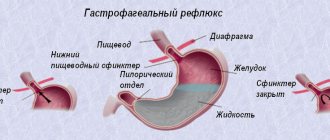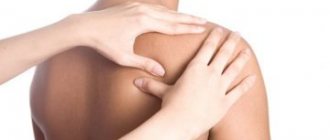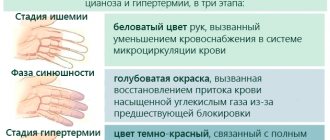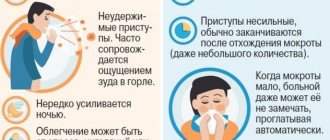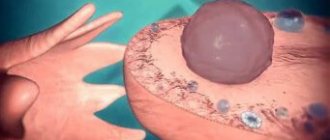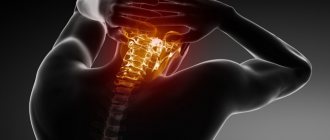24902
Sometimes a person is struck by excruciating pain localized in the lower half of the face. This feeling is constant and sharp.
This manifestation is typical for trigeminal neuralgia. What are the main symptoms, causes and methods of treating this pathology?
Structure of the trigeminal nerve
Our cranial system is very extensive, it includes twelve pairs of nerves, each of which helps the body work harmoniously. The fifth in this system is the trigeminal nerve (its endings depart from a part of the brain called the “pons”, located in the cerebellum), and it originates in the temporal region, next to the ear. Next, the nerve branches into three main guides, which together spread across the face and send impulses to every corner of it, even the most secluded corner:
- first branch: orbital,
- second branch: mandibular,
- third branch: goes to the upper jaw.
Also, each of these branches, in turn, diverges into many more small branches and sensitive, motor roots, which extend to the ears, eyes, mouth, nose, forehead, muscles and temples, and connect them with the brain.
Without the coordinated work of the trigeminal nerve and all its branches, we would not be able to speak, chew, use and control our facial expressions so richly, feel cold and warmth on our facial skin, as well as other external stimuli.
Physiotherapeutic procedures
They are used as an auxiliary method of treatment. For trigeminal neuralgia, the following physiotherapy procedures are effective:
- acupuncture;
- paraffin treatment;
- Bernard currents;
- electrophoresis with analgesics;
- bioptron;
- laser therapy in the area where the branches of the trigeminal nerve exit the skull.
There are recommendations for the use of alcohol-novocaine blockades. The injection is made in the area of the exit points of branches n. trigeminus. However, they give a short-term effect; with repeated repetitions, their effectiveness decreases.
Why can a nerve become inflamed?
Signs of inflammation of the trigeminal nerve can actually occur in anyone, because... there are too many prerequisites for their development.
Poor circulation or pinched nerve endings
What could cause this situation? Internal pathological conditions of the body, for example, the appearance of tumors or adhesions, dilatation of cerebral vessels, abnormal position of the skull bones (such conditions are most often congenital), increased intracranial pressure and hypertension, arterial aneurysm, vascular atherosclerosis, the formation of specific plaques (multiple sclerosis), diseases ENT organs and sinusitis, cholesterol plaques on the walls of blood vessels, meningitis, epilepsy, cerebral palsy, stroke.
Dental problems
Gingivitis and periodontitis, complicated caries and pulpitis, malocclusion, difficult eruption of wisdom teeth - all these are provocateurs of a dangerous disease.
“Often, when pain appears in the facial area, patients make a diagnosis for themselves and suspect neuralgia, although in fact a sore tooth is to blame. That is why some of them hesitate and are in no hurry to go to the dentist, trying to endure it and take measures at home. And when the time comes to see a doctor, they are stunned by the news that the diseased tooth can no longer be saved and will have to be removed. To avoid such situations and not guess what caused the pain, always undergo preventive examinations from different specialists (dentist, therapist). After all, prevention was invented so that the problem was detected in time and you didn’t have to think about what and where it really hurts and why,” says E.R. Dzagurova, dentist-therapist.
Incorrect treatment
But the culprit can be not only the person who causes dental problems, but also the doctor who carries out the treatment. For example, the doctor could have made mistakes in prosthetics or filling teeth (he brought the filling material beyond the top of the tooth root). Also, the specialist could have administered anesthesia incorrectly and hit the trigeminal nerve.
Pinching and then inflammation of the sensitive roots could occur after incorrectly performed maxillofacial operations and injuries received during their implementation, extraction and implantation of teeth (a dental specialist selected an unsuitable implant or did not take into account the presence of inflammation in the nasal sinuses at the time of preparation for the procedure) , surgeries to increase jaw bone tissue.
Decreased immune strength of the body
Banal hypothermia can become an impetus for inflammation of the trigeminal facial nerve. Don't wear a hat outside in the cold? Then don’t be surprised that at some point even washing your face with cold water will provoke a severe attack of pain due to inflammation of the trigeminal nerve. This can also be caused by stress, lack of vitamins in the body, old age, common herpes, periods of hormonal changes and menopause in women, pregnancy, overexertion, a tendency to allergies, physical overload, and intoxication of the body.
Other life-threatening diseases
These include tetanus, botulism, malaria, polio, tuberculosis, HIV, AIDS, syphilis, diabetes and problems with the body's endocrine system.
On a note! Some scientists believe that psychosomatics may be to blame for neuralgia, i.e. the disease causes nothing more than internal experiences and emotions, unresolved psychological problems, feelings of fear and loneliness. But metaphysicians claim that inflammation of the trigeminal nerve may even be associated with personal qualities: shyness, the desire to appear better in the eyes of others than we really are. But whatever the cause of the pathology, in no case should it be ignored, and here the main task of everyone is to contact a specialist in a timely manner.
Causes
The factors that provoke neuralgia differ in their nature of influence. Compression by adjacent blood vessels has been identified as the main cause of inflammation of the trigeminal nerve. They compress it at the base of the skull, thereby causing nerve irritation and pain.
Photo: Trigeminal facial nerve
The following causes are also often diagnosed:
- tumor-like formation that pinches a nerve;
- multiple sclerosis with pronounced destruction of cell myelin . Most often, pathology caused by this reason is detected in people under 25 years of age;
- past viral infection . Herpes is considered the most dangerous virus. Neuralgia also occurs with other infections if the inflammation caused by them is long-lasting and progressive;
- hypothermia . It is not necessary to receive general cooling for pathology to occur. Sometimes it’s enough just to be in a draft without a hat;
- decreased protective properties of the immune system;
- stress , leading to sustained mental overstrain;
- excessive physical activity without adequate nutrition , which leads to depletion of muscle and nerve tissue.
Types of neuralgia
True neuralgia: the cause is impaired blood supply and compression of the nerve. Signs: pain is periodic, paroxysmal in nature.
Secondary or “symptomatic”: always develops against the background of a disease or infectious process already occurring in the body.
Doctors also distinguish pathologies by type depending on the location of the inflammatory process:
- if the first branch is inflamed: a person may lose sensitivity of the eyelids and eyeballs, feel pain in the frontal areas of the sinuses, in the temples,
- if the second branch is inflamed: the functionality of the jaw is impaired (mainly the upper jaw and zygomatic region are affected), the lower eyelid, the maxillary sinuses, the nasolabial triangle,
- if the third branch is inflamed: you will experience severe pain in the entire lower part of the face, in the tongue, and will not be able to fully chew food.
Also, several branches can be affected simultaneously, but this situation is considered quite rare. More often, the branches become inflamed separately; most of the pathology occurs with the first and second.
Prevention
It is quite difficult to predict the occurrence of neuralgia. But there are a number of measures that will help reduce the risk of inflammation of the facial nerve:
- Timely treatment of infectious diseases such as sinusitis, sinusitis, pulpitis and others;
- Avoiding drafts and hypothermia;
- Minimizing stressful situations;
- Avoiding facial injuries.
And an equally important criterion is supporting the immune system by leading a healthy lifestyle, giving up bad habits, and frequent walks in the fresh air.
How to identify the disease
Inflammation of the trigeminal nerve, of course, has quite pronounced symptoms. We will consider each of them in detail in the table presented.
| Sign | Description |
| Pain |
|
| Skin sensitivity, numbness |
|
| Muscle spasms |
|
| Stress |
|
The symptoms listed above appear very clearly, but there are also signs that experts call secondary. Partially or completely, they almost always accompany inflammation of the trigeminal nerve, but it can be quite difficult for the patient to recognize them, coupled with existing problems: increased secretion of salivary secretions, distortion of taste sensations from eating familiar foods, the appearance of tear fluid in the eyes, secretion of mucous secretions from the nose , slight increase in body temperature, appearance of a rash.
Treatment of trigeminal neuralgia in multiple sclerosis
In demyelinating diseases, local destruction of the trigeminal nerve sheath sometimes occurs. Drug treatment consists of prescribing Misoprostol. Dosage 200 mcg three times a day. In Switzerland it is produced under the name Cytotec, in Austria Cyprostol.
If medications are ineffective for multiple sclerosis, percutaneous or radiosurgical methods are used. After a Gamma Knife procedure, almost 97% of people with MS are pain free. Glycerin injections have a lower effect. On average, improvement is observed within five years after treatment. Subsequently, you need to repeat the procedure.
Methods for diagnosing the disease
As you have already seen, neuralgia can occur in anyone, and often appears against the background of diseases that already exist in the body. Therefore, the main thing here is to make the correct diagnosis. And for this, in most cases, it is necessary to carry out not even one, but several different studies: MRI of the head, biochemistry and general blood test, electroencephalography, spinal cord puncture. A therapist can refer you for all these studies, and depending on their results, you will need to visit highly specialized specialists: a neurologist, an otolaryngologist, a dentist, a surgeon, a microsurgeon.
Diagnostics
Diagnosis is based on a typical history and neurological examination. Characteristic complaints suggest trigeminal neuralgia. You may need to consult an ENT doctor, dentist, or maxillofacial surgeon.
Instrumental examination is necessary to exclude or identify the cause of painful paroxysms. The following studies are shown:
- Magnetic resonance imaging (MRI) to diagnose vascular abnormalities, tumors, traumatic injuries, ischemia.
- Computed tomography (CT) to visualize the bony structures of the skull.
- Diagnosis of multiple sclerosis (visual and auditory evoked potentials).
The most important test is MRI. During diagnosis, neoplasms, sclerotic plaques, or vascular abnormalities compressing the trigeminal nerve are visualized.
However, in the case of classical neuralgia, in most cases it is not possible to detect any structural changes. This is because the vessel next to the nerve trunk is difficult to see even with high-quality MRI. Therefore, diagnosis is often based on a thorough analysis of complaints and medical history.
Treatment of neuralgia: an integrated approach
Inflammation of the trigeminal nerve is a serious disease, so its treatment should only be carried out under the supervision of a qualified specialist. It is also worth remembering that any one method, for example, only pills, will not eliminate the pathology. Here it is important to use a complex consisting of different techniques.
Medicines
How to treat inflammation of the trigeminal nerve? This is the case when the choice of tablets should be made only by a doctor who relies on reliable diagnostic data.
- for pain relief: “Baralgin”, “Ibuprofen”, “Nise”, “Spazmalgon”, “Ketanov”, “Ketalgin”. Drugs of this drug group should not be taken for more than several weeks in a row, otherwise the patient may experience problems with the gastrointestinal tract. Additionally, ointments can be used that are rubbed into the area of inflammation using massage movements. If the tablets do not give the desired effect, then doctors can prescribe ternary nerve blocks, which are carried out using injections of ethyl alcohol with novocaine,
- to eliminate cramps and spasms: “Carbamazepine”, “Konvulex”, “Difenin”, “Sirdalud”, “Clonazepam”,
- to relieve the inflammatory process: if the cause is, for example, a herpes virus, then the patient is prescribed “Acyclovir” or “Gerpevir”,
- to reduce tissue swelling, which contributes to nerve compression: “Methylprednisolone”,
- for the treatment of the underlying disease causing neuralgia: antibiotics,
- to reduce psychological stress: sedatives like Novo-Passit. Antidepressants such as Amitriptyline may also be prescribed.
- for dissolving cholesterol plaques: “Atoris”,
- to strengthen the immune system: vitamin complexes, echinacea-based products and rose hip syrup. To activate the immune system, homeopathic remedies such as Agaricus, Silicea, Traumeel (available in drops, ointments, injection solutions, contains fourteen herbal components) can also be prescribed.
- to restore the functioning of the central nervous system: B vitamins (B1, B6, B12), Neurobion.
IMPORTANT! All of the medications listed should not be taken as a guide to action if you have not yet visited your doctor! The complex of drugs for each individual patient must be selected individually!
Surgery
If drug treatment does not achieve positive dynamics, then doctors may decide to perform microvascular surgery (microvascular decompression), which involves separation of the nerve root, due to which the vessels are compressed. During the operation, specialists place a special material between it and the vessels, which will interfere with subsequent compression.
This method gives good results, for example, in 95% of patients who underwent surgery, there are no relapses of the disease over the next 7-8 years, and pain disappears almost immediately after the procedure in 98% of all patients.
The electrocoagulation method is also used, based on cutting the pain endings.
Also, specialists can perform a more complex operation called “radiofrequency destruction”, during which, using directed current pulses, the nerve roots in which the inflammatory process has occurred will be destroyed. Surgery is always performed only under general anesthesia.
If the cause of the pathology is the presence of tumors and neoplasms, then the surgeon also removes them. But such treatment and subsequent rehabilitation are always carried out only in a hospital setting.
Physiotherapy and massage
Typically, the patient is prescribed a course of 10-15 procedures of electrophoresis or magnetic therapy, ultraviolet heating, acupuncture, massage, and therapeutic exercises. But remember that, for example, the use of massage techniques that you yourself read on the Internet and are trying to implement at home can be dangerous if neuralgia is in an acute inflammatory or advanced stage.
Important! Experts try to treat inflammation of the ternary nerve in a child, as well as in pregnant women, in the safest ways, which is why massage and physiotherapy are most often prescribed to patients in these groups. All other measures are resorted to only in extreme cases.
Traditional methods
Traditional recipes are something that you can additionally use to treat inflammation of the trigeminal nerve at home, but only after consulting a doctor, and not as an independent choice:
- teas and decoctions for mouth rinsing from chamomile, marshmallow,
- black radish juice for rubbing,
- essential oils of sage and clay for applications,
- calcined buckwheat, salt, boiled egg for warming the diseased area: heating for ternary neuralgia can only be done in remission, otherwise your condition will only worsen, and the infection will spread through the bloodstream to neighboring areas of the body.
Treatment methods
If the process develops intensively, then it is necessary to seek help from a doctor as quickly as possible. After a detailed diagnosis, the exact cause will be identified and appropriate therapy will be selected.
For inflammation of this type, only complex treatment, which includes drug therapy, physiotherapy and traditional methods of treatment, .
Drug therapy
The effectiveness of treatment depends on properly selected drugs. The following drugs are mainly used:
- painkillers . Since attacks are associated with severe pain, both non-narcotic and narcotic drugs are used: “Ketanov”, “Ketalgin”, “Promedol”, “Morphine”;
- non-steroidal drugs with anti-inflammatory effects : Indomethacin, Dicloberl, Movalis, etc.;
- glucocorticoids . They are prescribed to relieve swelling and inflammation of nerve fibers. The most commonly used are Methylprednisolone, Hydrocortisone, and Dexamethasone;
- antispasmodics : “Sirdalud”, “Mydocalm”, “Carbamazepine”;
- antiviral agents : Lavomax, Acyclovir. Prescribed if the cause of inflammation is a virus.
Treatment of trigeminal neuralgia with medications should only be carried out under the strict supervision of a doctor who will correctly determine the drug and its dosage.
You will learn how to whiten teeth using tea tree oil in our article.
Well, here we’ll talk about the treatment of a fistula on the gum.
Follow the following link: https://zubovv.ru/protezirovanie/nesemnyie-p/koronki-np/obzor-tsen-na-zubyi-iz-metallokeramiki.html - you will look at photos of teeth made of metal ceramics and find out their prices.
Physiotherapy
Physiotherapy is an effective remedy, especially if used in conjunction with drug treatment. To eliminate primary symptoms and relieve inflammation, the following are most often used:
- electrophoresis . Quickly restores the condition of the trigeminal nerve, even during an acute period;
- UHF . Particularly effective for infectious neuralgia;
- paraffin-ozokerite therapy . After such procedures, facial muscle tension decreases and swelling decreases;
- magnetotherapy . Helps relieve pain and eliminate inflammation;
- massage . Helps relieve excessive muscle tension and increases the tone of the atrophied group. Typically performed in a sitting position.
Use of folk remedies
Photo: fir essential oil
Treatment with such drugs is aimed at relieving the symptoms of inflammation. For this use:
- essential oils: fir, sage, etc. They are applied in the form of applications or rubbed with gentle movements into the affected area. Oils help eliminate pain and activate metabolic processes in the deep layers;
- infusions and teas from herbs with anti-inflammatory effects: chamomile, marshmallow . These products are used both for oral administration and for rubbing;
- vegetable juice . Black radishes are good for this. To relieve inflammation and swelling, wipe the sore spot with juice several times a day;
- Calcined buckwheat or boiled egg are used as warming agents , which are applied to the inflamed area.
There are a large number of folk recipes that are used for inflammation of the trigeminal nerve. But do not forget that they are only an auxiliary means of the main therapy.
Inflammation of the trigeminal nerve is not always a curable disease. It depends on the neglect of the condition. Therefore, the sooner you see a doctor, the greater the opportunity to stop the pathology completely.
In conclusion, a video where we will be told about the symptoms and treatment of the inflamed trigeminal nerve:
If you find an error, please select a piece of text and press Ctrl+Enter.
Tags nerve symptoms trigeminal nerve
Did you like the article? stay tuned
Types of inflammation
Since each part of the trigeminal nerve is divided into smaller branches that lead to all areas of the face, the nerve covers it as a whole. These branches are responsible for facial sensitivity.
The first branch is responsible for the eyebrow, eye, upper eyelid and forehead. The second - for the nose, cheek, lower eyelid and upper jaw, the third - for some masticatory muscles and the lower jaw.
There are two types of disease:
- type one (true): the most common, occurs due to impaired blood supply or compression of a nerve, and is independent. In this type, the pain is severe, periodic and piercing;
- type two (secondary): a symptom, often a complication of a previous disease, arising as a result of complications of other diseases. With neuralgia of this type, the pain is burning and constant, and can occur in any part of the face.
The most popular cases of neuralgia of the nerve process are only on one side of the face, however, there are cases of inflammation of two or three branches at once, sometimes on both facial sides. The pain is intense, attacks last for 5-15 seconds, often reaching several minutes.
Causes
Over the entire period of research into the etiology of this disease, various authors have mentioned about 50 causative factors. It has been established that in 95% of cases the etiofactor is compression of the trunk and branches of the trigeminal nerve. Among the main causes of compression are the following:
- Vascular pathology. Expansion, tortuosity, or aneurysm of a vessel lying next to the nerve trunk leads to irritation and compression of the latter. The result is pain. Predisposing factors are cerebral atherosclerosis and arterial hypertension.
- Volumetric formations. Cerebral tumors, neoplasms of the skull bones, localized in the area where the trigeminal nerve exits the cerebral trunk or along its branches, begin to compress the nerve fibers as they grow. Compression provokes the development of neuralgia.
- Changes in skull structures. The narrowing of bone canals and openings that occurs as a result of head injuries, chronic sinusitis, and otitis is of etiological significance. A change in the relative position of cranial structures is possible due to malocclusion pathology or deformation of the dentition.
In some cases, damage to the nerve sheath and fibers is caused by herpetic infection, a chronic infectious process of the dental system (periodontitis, stomatitis, gingivitis). In some patients, trigeminal neuralgia develops against the background of a demyelinating disease. Factors that provoke the occurrence of pathology include hypothermia, dental procedures, increased chewing load, and in the case of infectious genesis - decreased immunity.
We suggest you read: Toothache radiates to the temple, can a tooth hurt your ear, what should you do?
The clinical picture consists of paroxysms of prosopalgia (facial pain), characterized by a series of intense pain impulses running from the lateral surface of the face to the center. Patients describe the pain syndrome as “electric shock”, “lumbago”, “electric discharge”. The attack lasts up to two minutes and is repeated many times. The localization of pain depends on the location of the lesion. With pathology of individual branches, pain impulses occur in the supraorbital region, along the zygomatic arch, and lower jaw. Damage to the trunk leads to pain spreading to the entire half of the face. The behavior of patients at the moment of paroxysm is characteristic: they freeze in place, are afraid to move, to speak. Despite the high intensity of pain, patients do not scream.
Trigeminal paroxysm is potentiated by various external influences: wind, cold air and water, shaving. Since the provoking factor can be the load on the facial and masticatory muscles, patients avoid opening their mouths wide, talking, laughing, and eating hard foods. Trigeminal neuralgia is characterized by a recurrent course. During the period of remission there are no paroxysms. Subsequently, symptoms of loss of function of the trigeminal nerve appear - decreased sensitivity of the facial skin. The symptomatic form occurs with a combination of typical pain attacks and other neurological symptoms. Possible nystagmus, symptoms of damage to other cranial nerves, vestibular syndrome, cerebellar ataxia.
In order to select adequate treatment for trigeminal neuralgia, you need to have a good understanding of the causes of the disease. And there are many of them:
- Compression of all or one branch of the trigeminal nerve;
- Inflammatory diseases of the paranasal sinuses
- Cerebral aneurysm;
- Dental diseases;
- Chronic infectious diseases – tuberculosis, brucellosis, malaria;
- Metabolic disorders - diabetes, gout
- Brain tumors (see signs of a brain tumor)
In practice, doctors more often encounter peripheral trigeminal neuralgia, the cause of which is the compression factor (compression). The branches of the trigeminal nerve are compressed for a long time when:
- some dental diseases;
- neoplasms in the area of the maxillary sinus;
- purulent sinusitis.
In addition to the compression factor, pain in the facial area can be provoked by injuries, psycho-emotional stress, chronic foci of infection, and changes in weather.
Branches of the trigeminal nerve
Diagnosis by a neurologist is not difficult, because the symptoms of trigeminal neuritis are typical:
- Complaints of burning, shooting and unbearable pain in the areas of innervation of the trigeminal nerve. Some patients compare these sensations to electric shocks.
- On average, a painful attack lasts 20 seconds, sometimes longer – up to one and a half minutes.
- There are gaps between attacks of pain.
- An attack can be provoked by pressing on certain areas of the face in the area of innervation of the nerve.
- During an attack, the patient is stiff and practically motionless. Facial and chewing muscles may twitch.
- Clear localization of pain that does not change.
Innervation zones of the trigeminal nerve
Even during remission, many chew food only on one side of the jaw, which is why seals form on its “inactive” half, the signs of which are revealed by palpation. A long-term disease passes into a dystrophic stage, as evidenced by atrophic changes in the masticatory muscles.
The trigeminal nerve consists of three branches: the ophthalmic, maxillary and mandibular. In turn, the branches are divided into small vessels extending from them, and thus the trigeminal nerve covers almost the entire face, providing movement of certain muscle groups and sensitivity of the skin, mucous membranes of the mouth, eyes and nose.
Click on the picture to enlarge
The picture on the right shows the main branches and areas of pain characteristic of each of them.
The main symptoms of the disease are painful attacks localized in the face. Pain with trigeminal neuralgia has its own characteristics:
- Pain usually begins in people from one point - from the edge of the mouth or nose, from the temple, from the gums or teeth. and the area of pain characteristic of each of them. Most often, the pain covers most of the face on one side.
- The pain feels like a burning, piercing, drilling pain.
- The painful attack is intense, but usually short-lived. It lasts no more than 2 minutes.
- Attacks one after another can last for several hours. The pain-free period lasts several minutes.
- At a moment of sharp pain, a person may freeze with a grimace on his face.
- Facial hyperemia is often observed, salivation increases, and lacrimation appears.
- At the height of a painful attack, reflex irritation of the receptors leads to twitching of the facial muscles.
It is impossible to diagnose inflammation of the trigeminal nerve by external signs alone; all symptoms must be taken into account.
The face remains symmetrical, unlike, for example, neuritis. There are no local signs of inflammation itself.
Severe pain can also cause redness on the face, sweating, and tears. Insomnia adds circles under the eyes and redness of the eyes, but all this is typical for any severe pain.
Location of the main branches What might a person with severe pain look like?
What else is important to know
When the second and third branches of the trigeminal nerve are affected, the pain can be localized only in the teeth. Often, a person goes to the dentist and insists on having his teeth removed. A painful attack can be triggered by touching the area of the nasolabial triangle, laughing, chewing, or washing with cold water.
If there is no timely and correct treatment for inflammation of the trigeminal nerve, then attacks of pain become more frequent and longer in duration. Pain begins to occur when yawning, facial movements, and chewing food. There is a disturbance in sensitivity on the side of the face where neuralgia occurs.
This manifests itself as sharp pain upon accidental touching or numbness, a feeling of goosebumps crawling across the face. Symptoms of deterioration in general well-being gradually appear, which is manifested by irritability, insomnia, and lethargy. Neuralgia often provokes the development of a severe depressive state.
Inflammation of the branches of the trigeminal nerve is a chronic pathology; periods of exacerbation of the disease can be triggered by any minor factor.
Before prescribing the correct treatment, the doctor must find out the cause of the pain.
The inflammatory process in the trigeminal nerve occurs as a result of its compression or changes in blood circulation. In turn, such pathological disorders are caused by both internal and external causes. These include:
- Neoplasms and adhesions affecting nerve branches.
- Arterial aneurysm.
- Dental problems. This could be an incorrectly installed filling on a tooth, periodontitis, pulpitis, or nerve injury during tooth extraction.
- Inflammatory phenomena in the nasopharynx and jaw area.
- Bacterial infection of the mouth.
- Atherosclerosis of the vessels supplying the branches of the trigeminal nerve.
- Injuries to the jaw and face.
- Under the influence of the above reasons, neuralgia most often develops if a person experiences hypothermia during the period of influence of provoking factors.
We invite you to read: How to make your teeth perfectly white? Price issue
Inflammation of the trigeminal nerve can also be a concomitant symptom of other diseases, such as:
- Multiple sclerosis.
- Metabolic disorders and pathologies of the endocrine system.
- Herpetic infection.
- Vascular pathologies.
- Psychogenic diseases.
The development of the disease mainly in postmenopausal women is explained by hormonal imbalance in the body. The risk of nerve inflammation also increases if there is a lack of essential microelements and vitamins in the body.
In order to prevent the development of inflammation of the trigeminal nerve, you must always monitor your health. Timely solution of dental problems, treatment of inflammatory diseases of the nasopharynx and ear, prevention of exacerbations of chronic metabolic disorders reduce the risk of developing neuralgia several times.
Surgical intervention is offered to a patient with trigeminal neuralgia if there are no positive results after three to four months of drug treatment. Surgical intervention can be divided into those aimed at eliminating the cause of the disease and those used directly to reduce the conduction of painful impulses along the branches of the trigeminal nerve.
general information
- The pain is characteristic - heterogeneous and inconsistent. The patient may either stop feeling it or feel it with redoubled force.
- The pain is uncharacteristic and lasts throughout the entire period of inflammation. It's not very pronounced, but you can't call it weak either. This pain covers a significant area, and it is much more difficult to treat such pain.
In any of the variants, neuritis is characterized by alternating deterioration and improvement. The course of this type of disorder is similar to any chronic disease.
Patients who are faced with this pathology, trying to prevent a second attack, try to reduce mobility, reduce the number of conversations and other usual actions.
- electroneurography;
- CT scan;
- Magnetic resonance imaging;
- electromyography;
- blood test for the presence of the virus and the state of immunity;
- dental x-ray;
- panoramic shot of the jaws.
In order to understand the root of the problem and completely eliminate it, a neurologist can refer the patient for examination to other specialists: an infectious disease specialist, an immunologist, a dentist, an ENT specialist, an ophthalmologist, an allergist.
Note! Pathologies of the trigeminal nerve are characterized by a high degree of difficulty in finding the causes. In view of this, in most cases, treatment is aimed only at relieving pain and inflammation and preventing re-exacerbation. And a complete cure is rarely possible.
There are two forms of trigeminal neuritis. Primary (idiopathic) develops with central damage to the nerve nuclei, while secondary (symptomatic) develops against the background of the influence of external causes on the branches of the nerve.
The mechanism of pain syndrome is as follows. The nerve contains 2 types of fibers - A and C. A-fibers are responsible for suppressing pain impulses, while C-fibers are responsible for strengthening them. With neuritis, demyelination of A-fibers occurs, deterioration of their function and the predominance of type C fibers.
Prevention and recommendations for patients
In some cases, no treatment is required (with low-intensity pain and rare exacerbations). If there is an increase in pain attacks with increased pain and the appearance of other symptoms of nerve damage, drug therapy should be carried out.
It is worth noting that conventional drugs from the NSAID group (diclofenac, nimesil, ketorol) do not have an effect, but on the contrary, they can worsen the course of the disease. These drugs become effective in the development of dental plexalgia, from which it is necessary to differentiate the development of trigeminal neuritis.
We suggest you read: Nerves are located in the dental canal
First-line drugs for the treatment of trigeminal neuritis are anticonvulsants (carbamazepine, Truxal). A day, in the initial stages, it is recommended to take 1 tablet 2 times, gradually increasing the dose to 2 tablets at a time.
In parallel, to potentiate the effect of the anticonvulsant drug, diphenhydramine or pipolfen solutions are prescribed intramuscularly.
In some cases, resort to the use of phenytoin.
Physiotherapeutic treatment includes the use of electrophoresis with novocaine, hydrocortisone, as well as the use of dynamic currents. Acupuncture in the acute period of pain syndrome is contraindicated.
If conservative methods are ineffective, as well as in the case of traumatic or tumor damage to the nerve, surgical treatment is resorted to.
Prevention of the disease comes down to observing the conditions for proper facial care, avoiding hypothermia and infectious diseases.
Was the page useful? Share it on your favorite social network!
Above we discussed in detail how to treat trigeminal neuralgia. It was mentioned earlier that this disease is difficult to treat and cannot always be completely defeated. Therefore, doctors advise adhering to certain rules that will reduce the risk of its development. Here are the most important ones:
- Healthy food;
- periodically carry out vitamin therapy;
- try not to get too cold;
- periodically undergo routine examination by a dentist;
- If you suspect any infectious diseases, immediately go to the hospital.
These preventative measures are very simple to implement, but they will help you avoid very serious health problems.
Conservative therapy
Let's take a closer look at this aspect. Once the presence of the disease is confirmed, the doctor selects the most effective treatment for the patient. The first thing you need for trigeminal neuralgia is to numb the affected areas. But if you do not eliminate the cause behind the disease, then no result will be achieved. Therefore, in most cases, complex therapy is carried out aimed at eliminating symptoms and combating underlying diseases.
Many people are interested in the question of how to treat trigeminal facial neuralgia. The doctor decides which medications will be used. Today there are many different medicines on sale that are highly effective in combating this pathology, but Carbamazepine is considered one of the best.
It helps to inhibit the passage of impulses along nerve fibers that cause pain. The dosage and duration of administration is calculated for each patient individually. But it’s worth noting right away that this disease requires long-term treatment, so you can’t count on a quick recovery.
It is important to take into account that the drug contains potent substances, so long-term use can lead to intoxication. Side effects include the following:
- sleep disorder;
- memory impairment;
- various mental disorders.
Carbamazepine is prohibited for use by pregnant women as it can cause fetal toxicity and lead to miscarriage. In addition, it should not be used by people with certain eye pathologies, heart blocks and various blood diseases. While taking these tablets for trigeminal neuralgia, you should refrain from eating grapefruits, since these fruits increase the risk of side effects. To increase the effectiveness of therapy, Carbamazepine is often prescribed together with Pipolfen.
Conservative therapy involves taking the following types of medications:
- anticonvulsants: Baclofen, Phenibut;
- antibiotics: “Gerpevir”, “Ceftriaxone”;
- psychotropic: "Diazepam";
- antipsychotic: "Pimozide";
- antidepressants: "Amitriptyline";
- venotonics: “Trental”, “Vitamin RR”;
- anti-inflammatory: “Milgama”, “Neurodiclovit”;
- analgesics;
- vitamin complexes.
Nonsteroidal anti-inflammatory drugs are often prescribed internally when treating facial neuritis to relieve inflammation and relieve pain. But they can also be included in gels or ointments for topical use. These are products such as Diclak, Diclofenac, Bystrum-gel.
Complications
The fear of provoking neuralgic paroxysm forces patients to chew only with the healthy half of the mouth, which leads to the formation of compactions in the muscles of the contralateral part of the face. Frequent paroxysms reduce the quality of life of patients, negatively affect their emotional background, and impair performance.
Intense excruciating pain, constant fear of another paroxysm can cause the development of neurotic disorders: neurosis, depression, hypochondria. Progressive morphological changes (demyelination, degenerative processes) cause a deterioration in the functioning of the nerve, which is clinically manifested by sensory deficits and some atrophy of the masticatory muscles.
- Decreased immunity.
- Asthenia of patients.
- Weight loss if eating triggers an attack.
- Decreased facial skin sensitivity.
- Atrophy of the skin and mucous membranes in the area of innervation of the trigeminal nerve.
- Decreased hearing and vision.
- Weakening of facial muscles.
- Mental disorders and depression, which can lead to suicide attempts.
Pathogenesis
The above etiofactors potentiate morphological changes in the sheath of the trigeminal nerve. Studies have shown that structural changes in the myelin sheath and axial cylinders develop 3-6 months after the onset of the disease. Local microstructural disorders provoke the formation of a peripheral generator of pathologically enhanced excitation.
Excessive impulses, constantly coming from the periphery, cause the formation of a central focus of hyperexcitation. There are several theories that explain the connection between local demyelination and the occurrence of a focus of hyperexcitation. Some authors point to the possibility of the emergence of transverse interaxonal impulse transmission.
The development of the disease is based on either a central component (impaired blood circulation in the core) or a peripheral component - an effect on the peripheral parts of the nerve (tumor, consequences of facial injuries, diseases of the paranasal sinuses). The presence of different mechanisms of neuralgia determines different approaches to treatment.
Vascular, endocrine-metabolic and immunological factors play a role in the pathogenetic mechanisms of neuralgia of central origin. Under the influence of these factors, the functional state of the sensitive nuclei changes and a focus of pathological activity is formed in the central nervous system. This entails the appearance of trigger zones in the areas of innervation of various branches of the nerve. Irritation of trigger zones causes an attack of pain in the face, but without loss of sensitivity.
The vascular factor is given leading importance in the pathogenesis of classical TN neuralgia. The nerve root is affected by an arterial loop that vertically crosses the root.
Vasculoneural conflict is of particular importance in old age, when hardening of the arteries and age-related demyelination of nerve fibers develop. Predominant damage to the second and third branches is associated with the shorter length of the axons that form these branches compared to the long first branch.
Inflammatory reactions during dental procedures and colds cause autoimmune processes that play a role in the development of pain syndrome in NTN. At the same time, the titer of antibodies to the myelin protein increases, which indicates demyelination. Therefore, treatment uses glucocorticoids to suppress autoimmune inflammation.
This is interesting! New in treatment
Today, the possibility of using transcranial magnetic stimulation (TMS) to eliminate trigeminal neuralgia is being considered. The method involves using a special magnetic electrode, which is installed under the bones of the skull. Due to electrical stimulation of brain tissue, an analgesic effect can be achieved. In Russia, this technique is practiced at the Scientific Center of Neurology.
Some clinics offer treatment with Botox. However, the drug gives only a short-term effect, on average for 2 months. After the pain returns, repeated injections of the drug are needed.
General information
The disease is described in detail in the following video:
The trigeminal nerve is the 5th pair of cranial nerves. The name is associated with its structure - it is a branched nerve formation containing 3 branches: the eyes (passes above the eyebrows), the maxillary (runs along both sides of the nose) and the mandibular (located in the lower jaw).
The first 2 branches have sensory fibers, and the 3rd additionally contains motor ones, which ensure the functioning of the masticatory muscles.
Classification
Neuralgia
- Primary (essential). The cause of the disease cannot be determined.
- Secondary (symptomatic) divided into central (classical, caused by compression of the trigeminal root by pathologically altered vessels) and peripheral (injuries of peripheral branches, jaw surgery, complex tooth extraction, compression by a tumor, etc.).
By dysfunction:
- Motor function is impaired.
- Sensory function is impaired.
- Traumatic.
- Infectious.
- Neurofibroma.
- Schwannoma.
- Neurolemmoma.
Systematization of the disease according to etiology is of practical importance. This principle underlies the determination of the most appropriate treatment tactics (conservative or surgical). According to the etiological aspect, trigeminal neuralgia is divided into two main forms:
- Idiopathic (primary). Caused by vascular compression of the trigeminal root, most often in the area of the brain stem. Due to the difficulties in diagnosing pathological vessel-nerve relationships, idiopathic neuralgia is assumed after excluding other causes of trigeminal pain syndrome.
- Secondary (symptomatic). It becomes the result of neoplasms, infections, demyelinating pathology, and bone changes. Diagnosed using neuroimaging and cranial tomography.
Symptoms
Symptoms of inflammation of the trigeminal nerve can be divided into conditional primary and secondary symptoms.
Pain syndrome
The first and main symptom of inflammation of the trigeminal nerve is pain. It can torment the patient for several days, weeks or months. After some time, even without appropriate treatment, pain may disappear, but this in no way indicates that the disease has receded .
The pain is localized in the places where the trigeminal nerve passes, that is, only one part of the face hurts. The starting points for the onset of pain syndrome can be the temple, wings of the nose, corners of the mouth, and jaw. The location of the pain in the jaw area very often prevents the doctor from making an accurate diagnosis. The fact is that the same manifestations are characteristic of toothache caused by dental problems.
Painful sensations when the trigeminal nerve is damaged appear in the form of acute, piercing, short-term spasms. Such spasms are almost impossible to calm by taking painkillers. They can occur during palpation of the face, chewing, facial expressions, or simply out of the blue.
Pain with trigeminal neuralgia is conventionally divided into two types:
- Typical.
- Atypical.
Typical pain manifests itself as sudden, paroxysmal spasms spreading over the entire right or left side of the face. Such spasms are somewhat reminiscent of electrical discharges. Typical pain comes on suddenly and goes away just as quickly. Its duration does not exceed a couple of minutes, and the frequency can reach several times an hour, but after a couple of hours it completely disappears.
Atypical pain can be identified by prolonged, severe pain throughout the whole day or several days. The pain syndrome can be located throughout the face and be accompanied by a tic.
Secondary symptoms
If the trigeminal nerve is inflamed, then along with unbearable pain the patient may experience other manifestations:
- swelling and redness of the eyelids;
- uncontrolled, increased salivation;
- tearing eyes;
- violation of taste buds;
- numbness of the face;
- sleep problems;
- weakness and chills;
- muscle spasms;
- facial asymmetry;
- pallor and redness of the skin;
- dry or oily skin;
- rashes and itching on the skin of the face;
- headache;
- painful tic on the face;
- distorted facial expressions and grimaces;
- increased body temperature;
- insomnia, irritability, anxiety.
In the following image you can see how the face changes with facial neuralgia:
